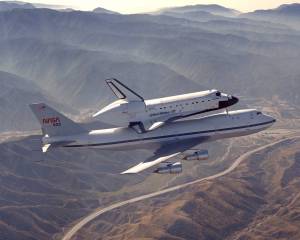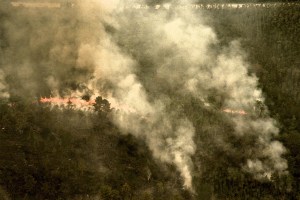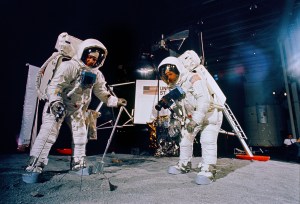Fourth of July Holidays in Space
It may seem remarkable that no American spent the Fourth of July holiday in space for the first 21 years of human spaceflight. Not until 1982 and the 35th U.S. human spaceflight did Americans awaken in space on Independence Day, and then bring their spacecraft back to Earth later in the day to a rousing […]

It may seem remarkable that no American spent the Fourth of July holiday in space for the first 21 years of human spaceflight. Not until 1982 and the 35th U.S. human spaceflight did Americans awaken in space on Independence Day, and then bring their spacecraft back to Earth later in the day to a rousing welcome by the President of the United States. Another 10 years elapsed before more Americans found themselves in orbit on July 4. But as flight rates and crew sizes increased, and as Americans began living and working aboard space stations, spending the holiday in orbit turned into an annual event, celebrated with crew members from other nations. Through 2024, 73 Americans have celebrated Independence Day in space, eight of them twice, each in a unique style.
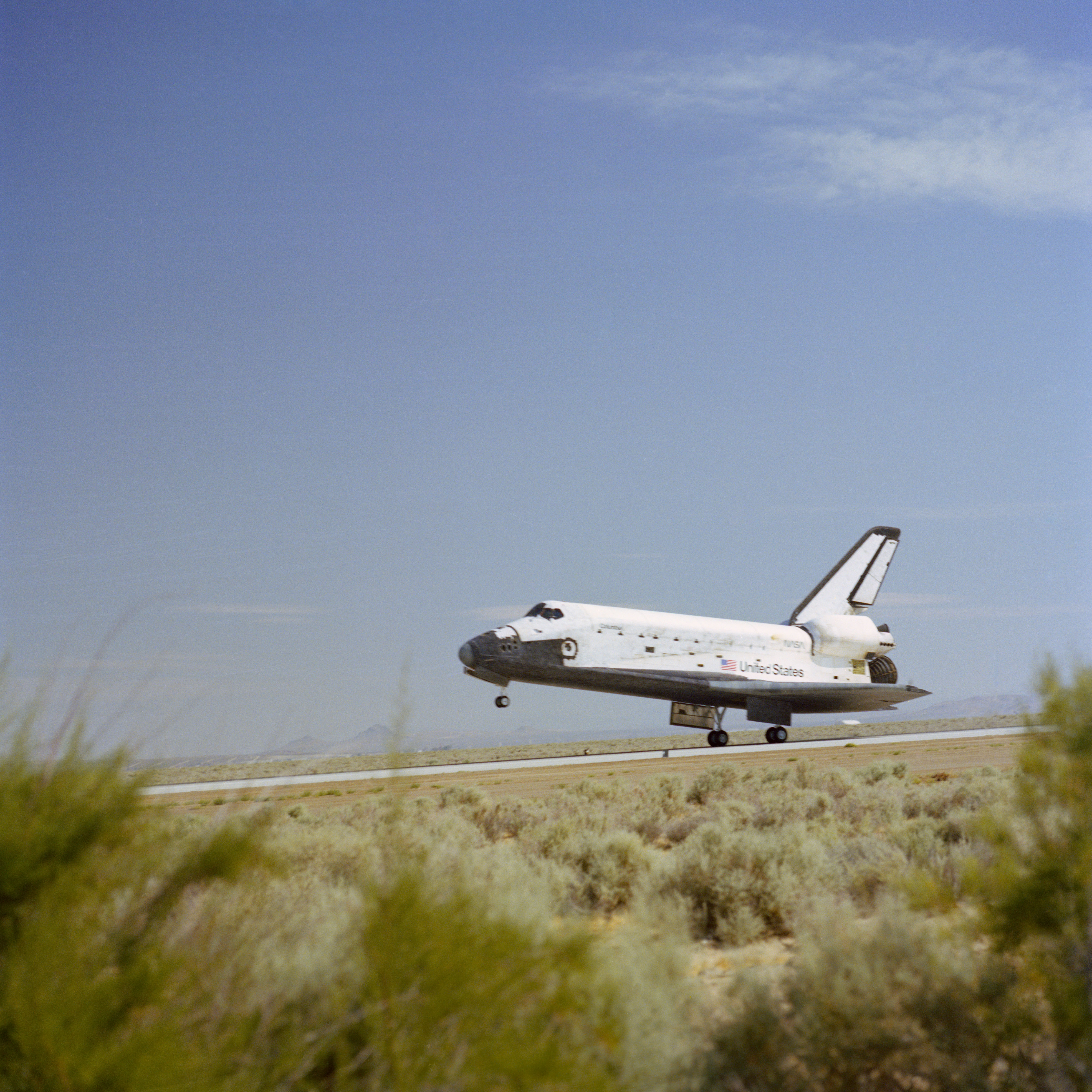
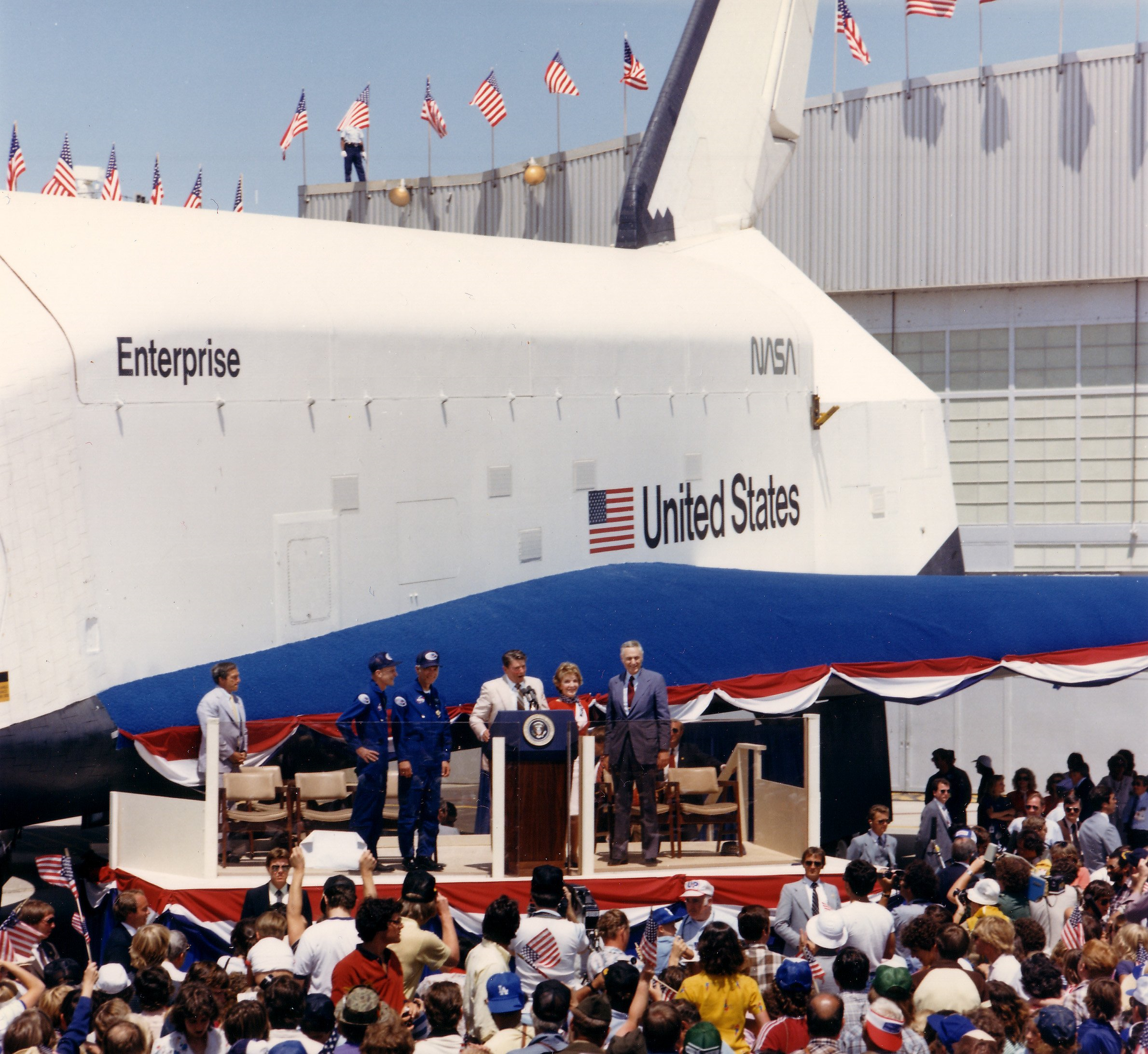
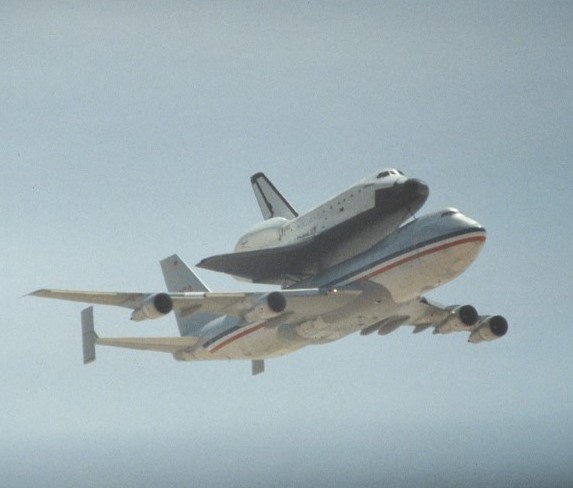
July 4, 1982 – A tale of three shuttles. Left: Space shuttle Columbia makes a touchdown at Edwards Air Force Base (AFB) in California to end the STS-4 mission. Middle: With space shuttle Enterprise as a backdrop, President Ronald W. Reagan, First Lady Nancy Reagan, and NASA Administrator James M. Beggs welcome home STS-4 astronauts Thomas K. “TK” Mattingly and Henry W. Hartsfield. Right: Space shuttle Challenger departs Edwards AFB atop its Shuttle Carrier Aircraft on its way to NASA’s Kennedy Space Center in Florida.
For the first 21 years of human spaceflight, no American astronaut had spent a Fourth of July in space. That all changed with the STS-4 mission. On July 4, 1982, the final day of their flight, astronauts Thomas K. ‘TK’ Mattingly and Henry W. “Hank” Hartsfield guided space shuttle Columbia to its first concrete runway landing at Edwards Air Force Base in California. President Ronald W. Reagan, who two years later instructed NASA to develop a space station, and First Lady Nancy Reagan greeted Mattingly and Hartsfield on the runway as they disembarked from Columbia. Shortly thereafter, the President led a celebration in front of space shuttle Enterprise, saying, “TK and Hank, you’ve just given the American people a Fourth of July present to remember.“ To cap off the event attended by 45,000 people and broadcast live on television, President Reagan gave the signal for the Shuttle Carrier Aircraft carrying Challenger, NASA’s newest space shuttle orbiter, to take off to begin its transcontinental ferry flight to NASA’s Kennedy Space Center (KSC) in Florida.
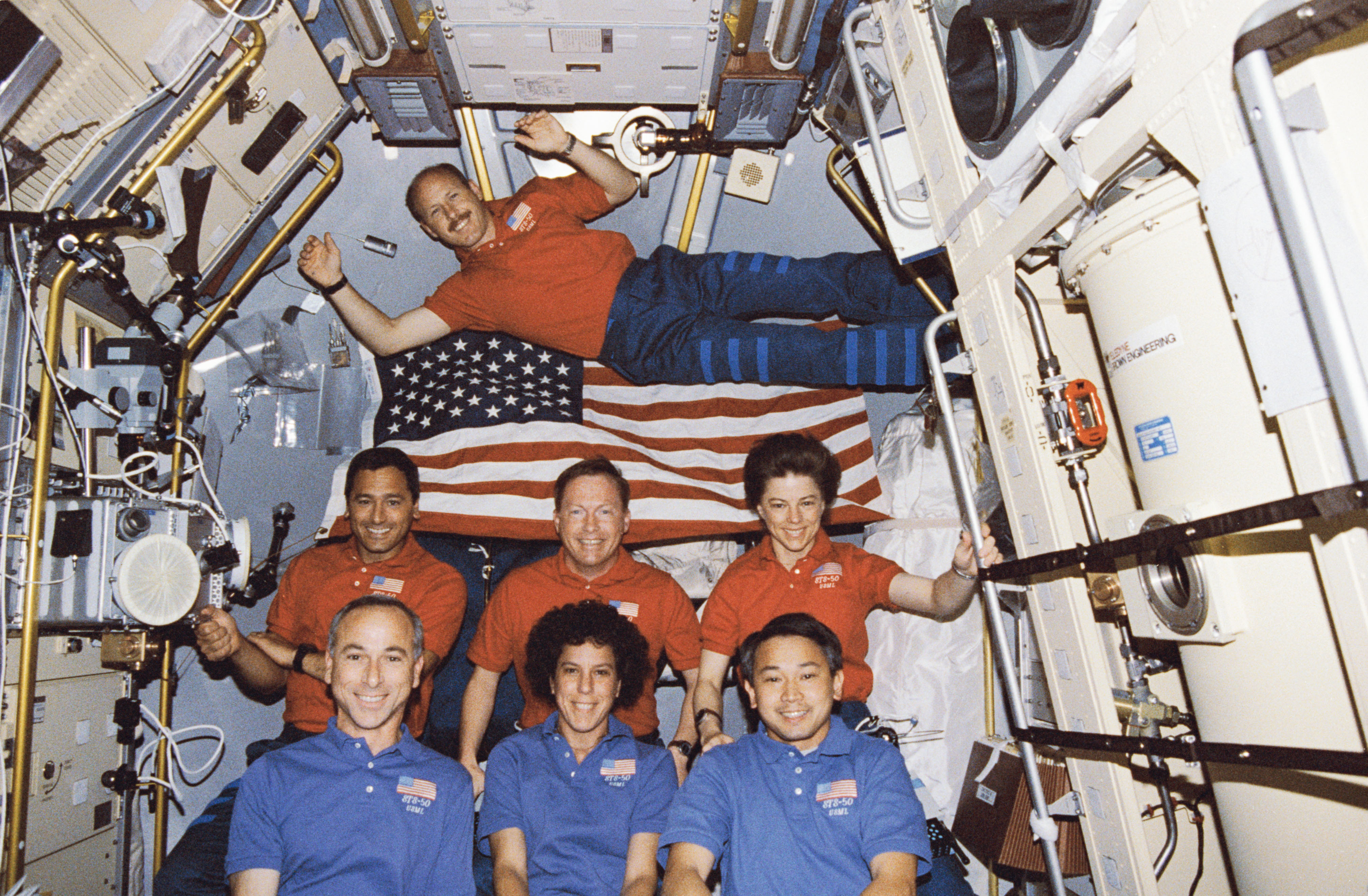
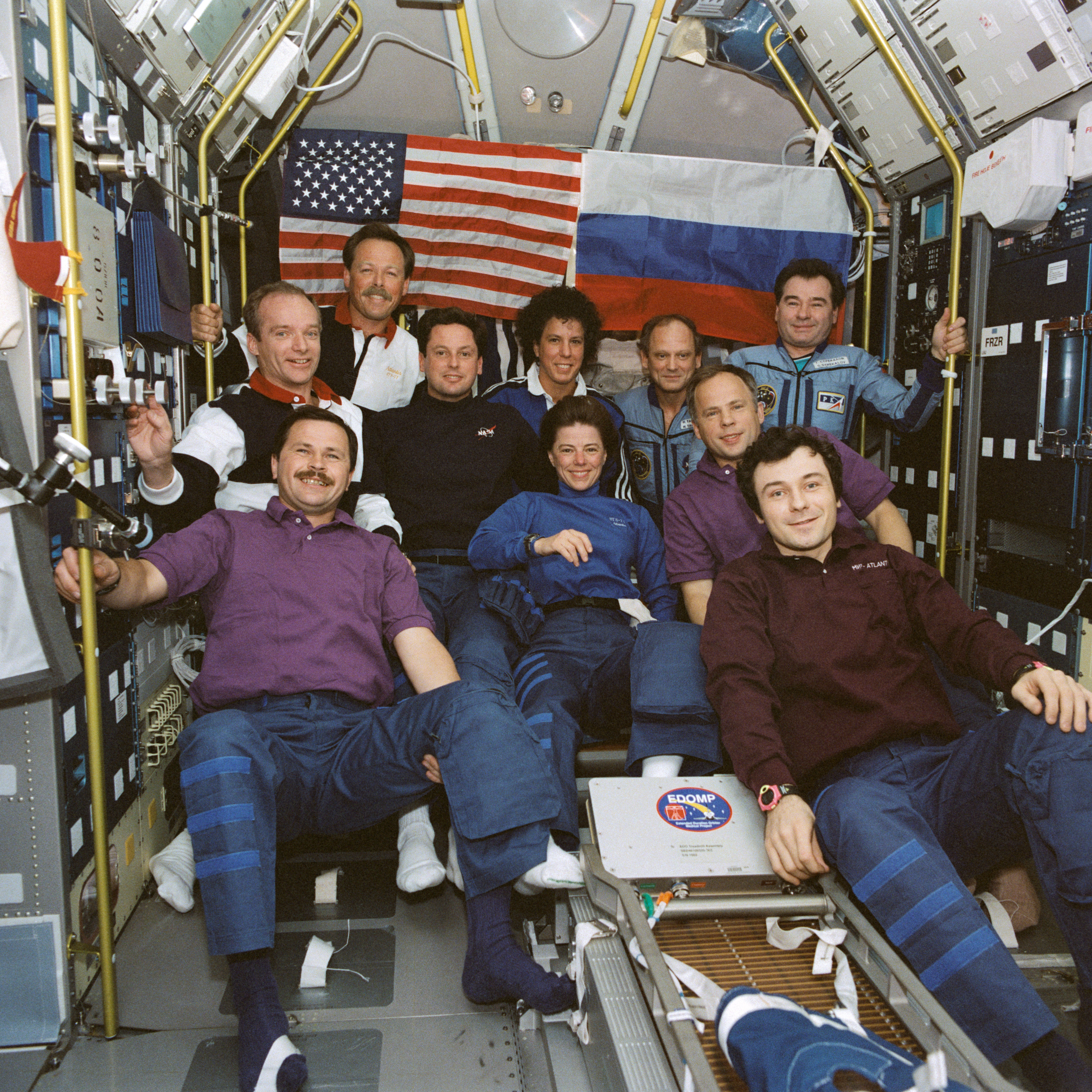
Left: The STS-50 crew in July 1992. Right: The international STS-71 crew in July 1995.
Ten years passed before American astronauts once again celebrated the Fourth of July holiday in space. The seven astronauts of STS-50 had completed about half of their 14-day USML-1 mission on July 4, 1992, but the busy pace of the science flight allowed little time for celebrations. Three years later, 10 people orbited the Earth during the historic STS-71 first shuttle docking mission to the Mir space station. In fact, on July 4, 1995, space shuttle Atlantis undocked from Mir, returning NASA astronaut Norman E. Thagard and his two cosmonaut colleagues from a four-month mission aboard Mir. By coincidence, for NASA astronauts Bonnie J. Dunbar and Ellen S. Baker, this marked their second Fourth of July in space as they both served on the STS-50 crew three years earlier. The day’s undocking activities left little time for celebrating, although Mission Control played “America the Beautiful” as the wake-up song that morning. To satisfy Thagard’s request, following their landing at KSC, ground teams treated him and his colleagues to some belated Fourth of July fare of hot dogs, hamburgers, and hot fudge sundaes.

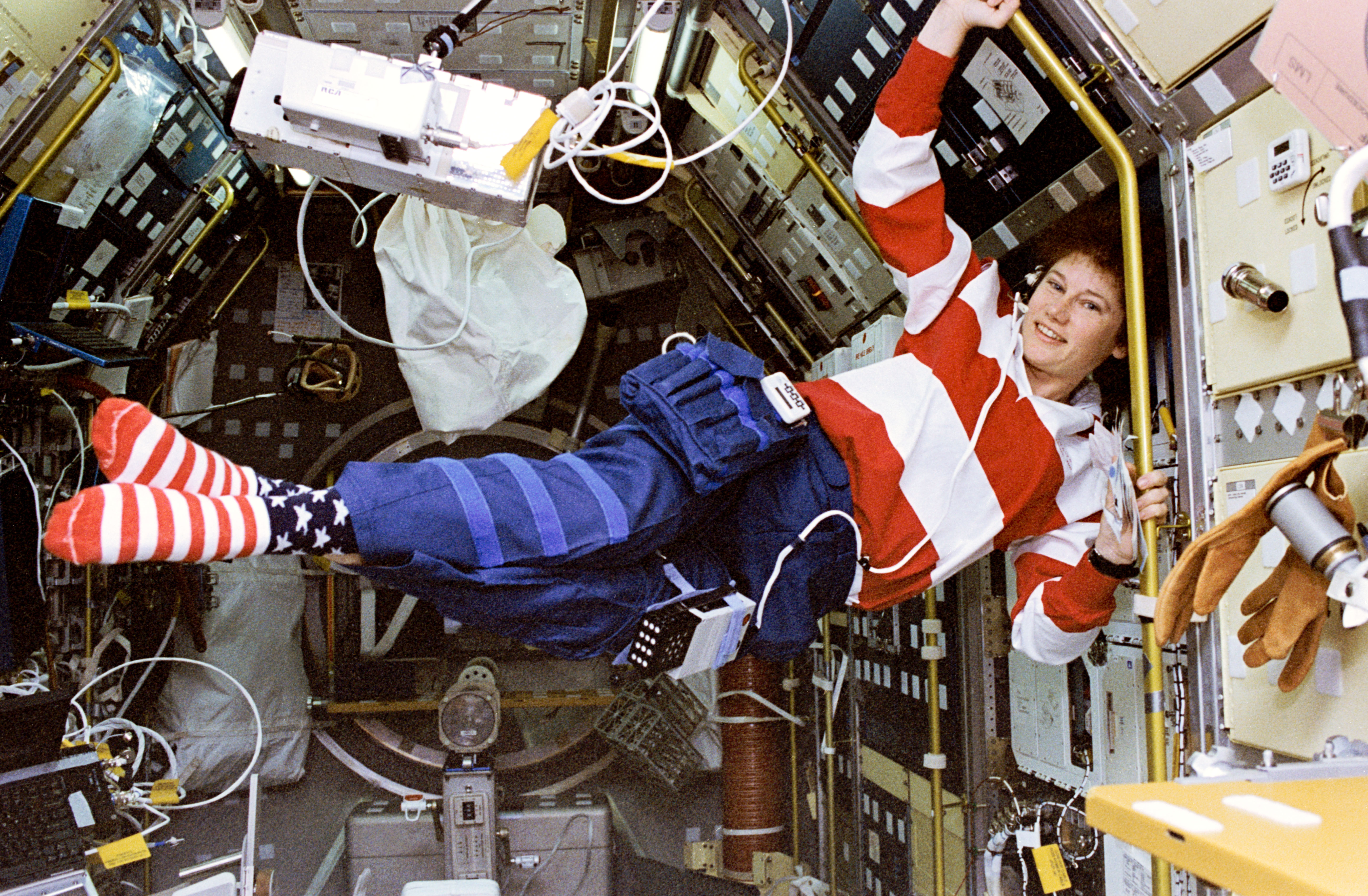
July 4, 1996. Left: Shannon W. Lucid aboard the space station Mir. Right: Susan J. Helms in the Spacelab module during the STS-78 mission.
Following Thagard, six other NASA astronauts completed long-duration missions aboard Mir. From March to September 1996, Shannon W. Lucid spent six months aboard the Russian station and as the lone American on the Mir 21 crew, she celebrated the Fourth of July by wearing distinctive Stars-and-Stripes socks. Elsewhere in low Earth orbit, with much of their 17-day Life and Microgravity Sciences mission behind them, the international crew of STS-78 celebrated the Fourth of July holiday aboard space shuttle Columbia. By sheer coincidence, astronaut Susan J. Helms wore Stars-and-Stripes socks identical to Lucid’s.
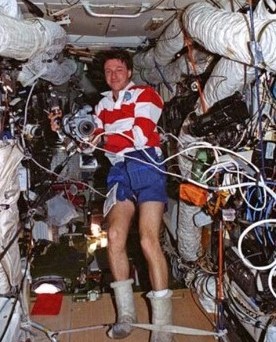
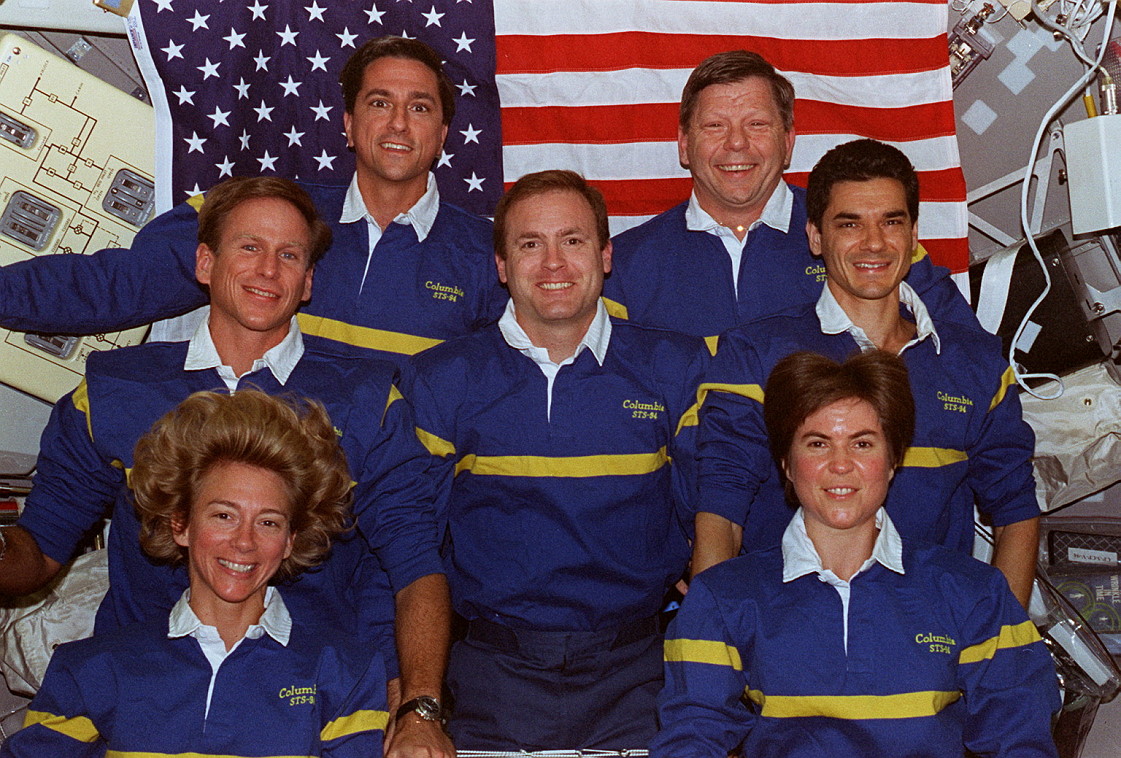
July 4, 1997. Left: C. Michael Foale aboard the space station Mir. Right: The STS-94 crew aboard space shuttle Columbia.
In 1997, C. Michael Foale took his turn as the resident NASA astronaut aboard Mir. On June 25, a Progress cargo vehicle collided with the station, depressurizing its Spektr module, the one Foale used as sleeping quarters and as a laboratory. On July 4, Foale and his two cosmonaut colleagues, still dealing with the accident’s aftermath and preparing to receive a new cargo craft with critical supplies, did not have time for celebrations. Foale spoke with NASA Administrator Daniel S. Goldin, who called to check on his status and wish him a happy holiday. Concurrently, the seven-member all-NASA STS-94 crew also spent July 4, 1997, in space during the Microgravity Science Laboratory mission aboard space shuttle Columbia. With eight NASA astronauts in orbit, although aboard two spacecraft, this still holds the record as the largest number of Americans off-planet on a Fourth of July.
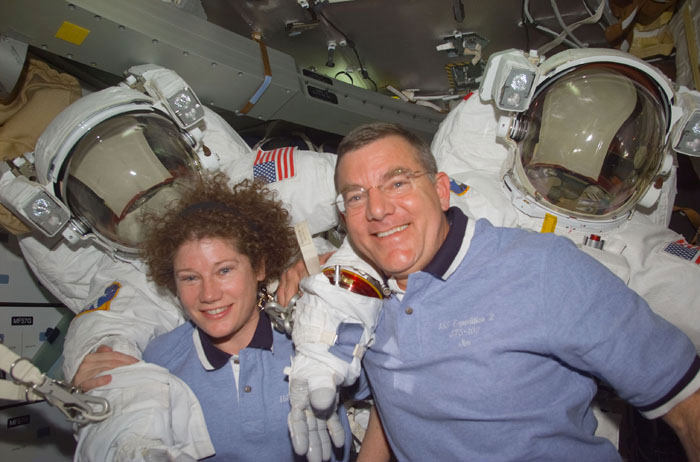
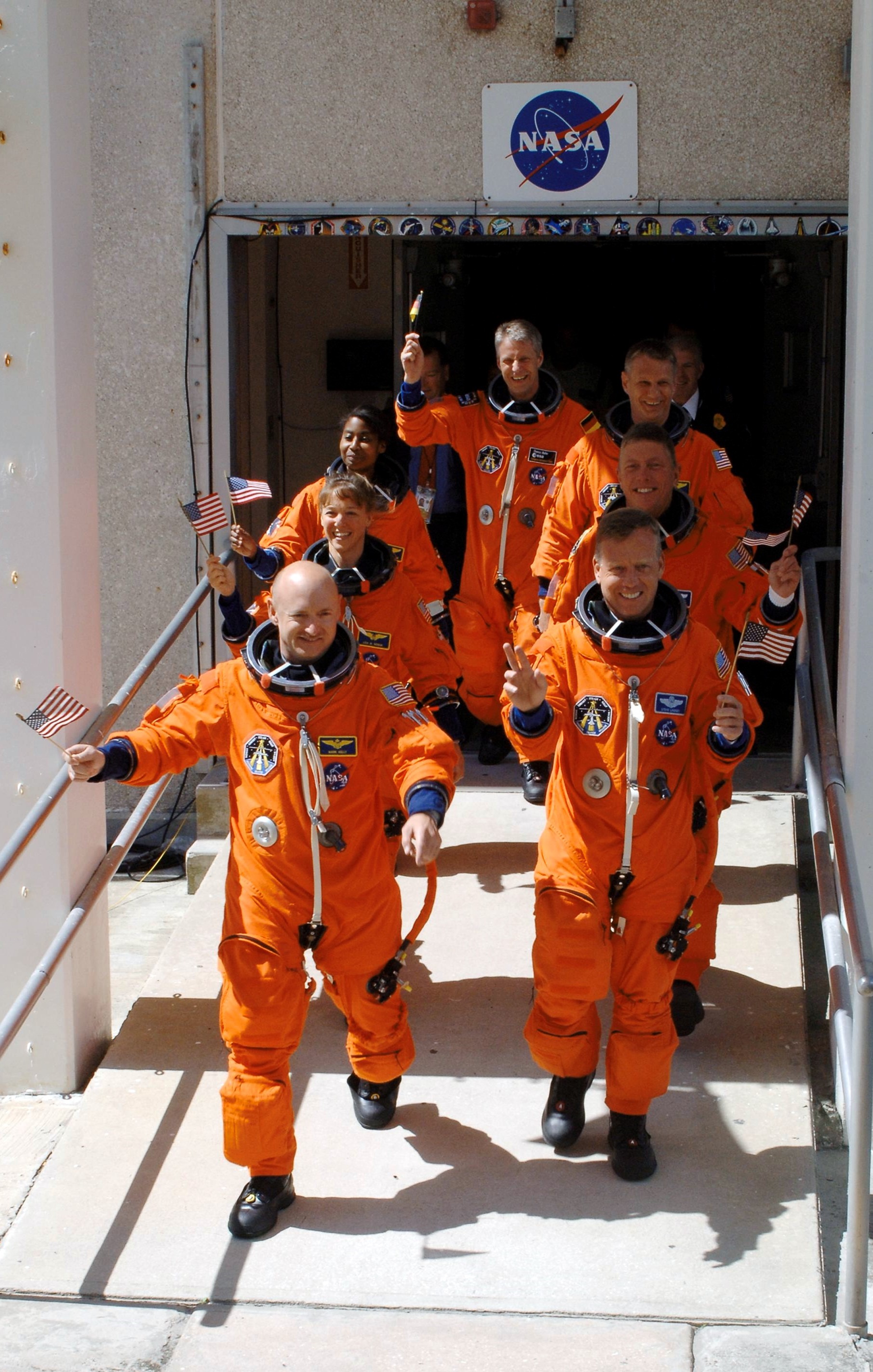
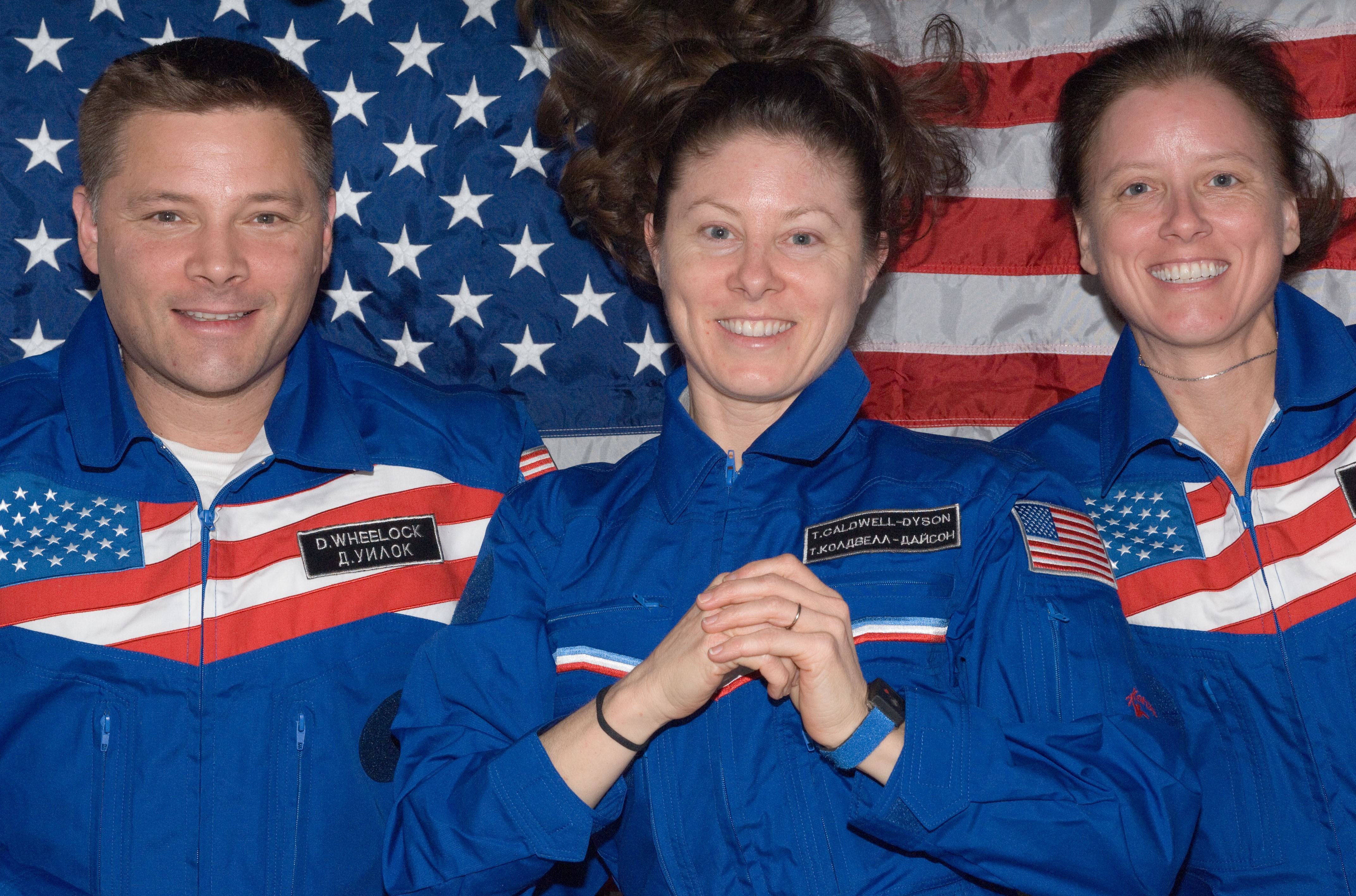
Left: July 4, 2001. Expedition 2 crew members NASA astronauts Susan J. Helms, left, and James S. Voss. Middle: July 4, 2006. The crew of STS-121 wave American (and one German) flags as they depart crew quarters for their Fourth of July launch. Right: July 4, 2010. NASA astronauts Douglas H. Wheelock, Tracy Caldwell Dyson, and Shannon Walker of Expedition 24.
The start of continuous human habitation aboard the International Space Station in November 2000 has meant that every year since, at least one American astronaut has spent the Independence Day holiday in space. James S. Voss and Susan J. Helms of Expedition 2, the first NASA astronauts to spend the Fourth of July aboard the space station in July 2001, sent an “out of this world” birthday message to America, played during “A Capitol Fourth” celebration in Washington, D.C. For Helms, this marked her second July 4 spent in space in five years. For each of the next eight years, crew rotations and other factors resulted in only one NASA astronaut residing aboard the space station during the Fourth of July holiday. Celebrations tended to be low key, but the entire crew regardless of nationality had the day off from their regular duties. July 4, 2006, marked the first and so far only time that an American crewed spacecraft launched on Independence Day, the liftoff like a giant birthday candle. As they left crew quarters for the ride to the launch pad, the seven-member crew of STS-121 waved flags, six American and one German, for the European Space Agency astronaut. With Jeffery N. Williams working aboard the space station, once the STS-121 crew reached orbit, the seven NASA astronauts comprised the largest number of Americans in space on Independence Day since 1997. In 2010, Expedition 24 marked the first time that three NASA astronauts, Douglas H. Wheelock, Tracy Caldwell Dyson, and Shannon Walker, celebrated the Fourth of July aboard the space station. Wheelock marked the holiday by posting a message on social media about a Congressional Medal of Honor belonging to a soldier killed in action in Vietnam that he took to space.
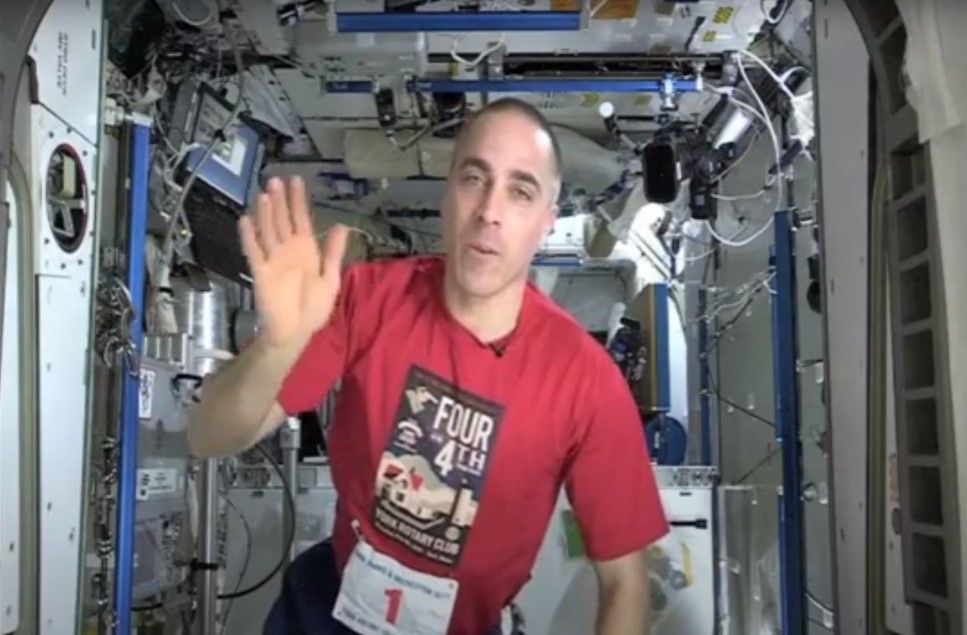
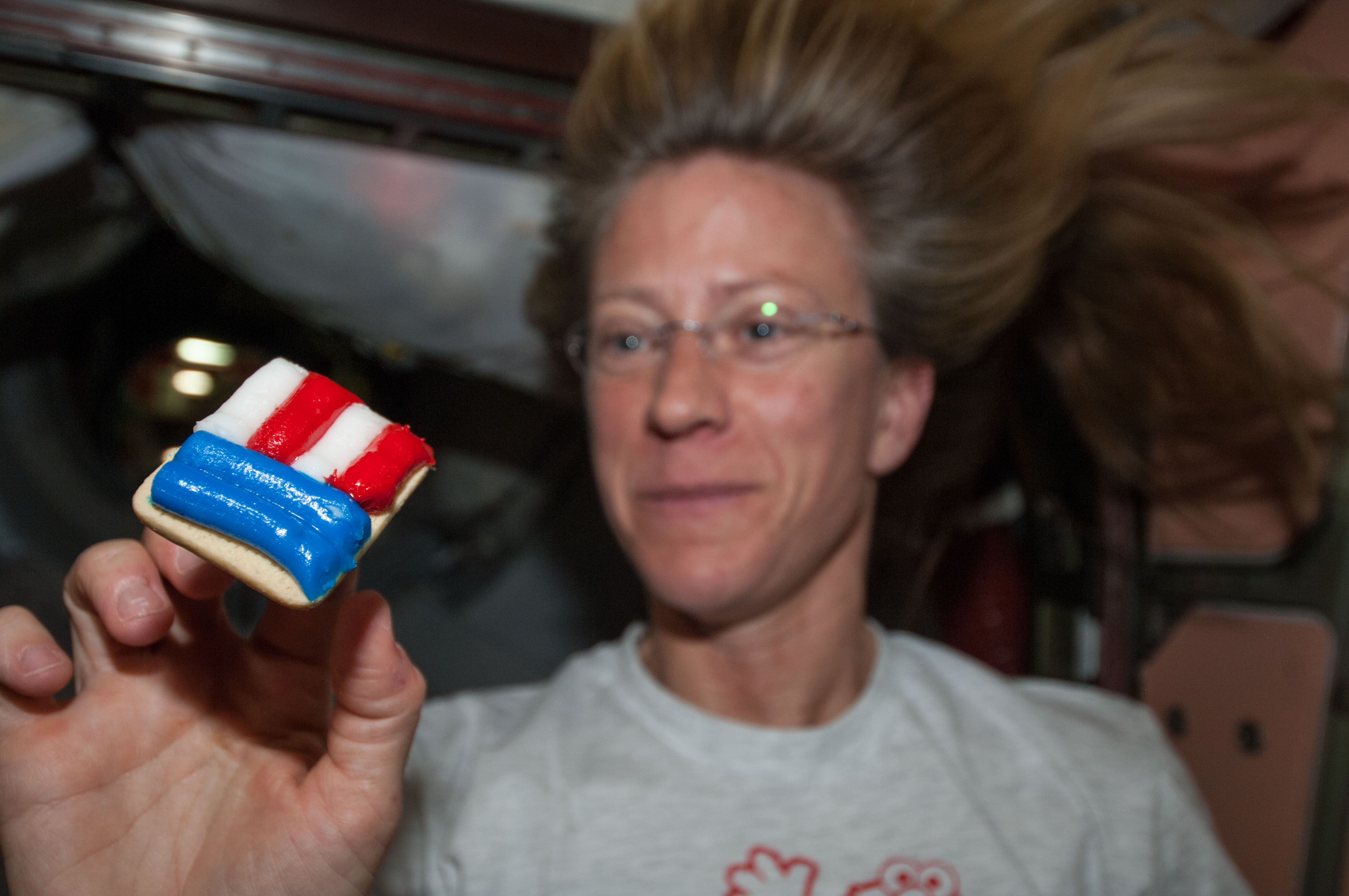
July 4, 2013. Left: Expedition 36 astronaut Christopher J. Cassidy wears a T-shirt from the Four on the Fourth race in York, Maine. Right: Fellow Expedition 36 astronaut Karen L. Nyberg displays her Fourth of July creation of a cookie she iced in the colors of the American flag.
For Independence Day 2013, Expedition 36 astronaut Christopher J. Cassidy chose to run in the Four on the 4th road race in his hometown of York, Maine. The fact that he lived and worked aboard the space station did not stop him from participating. Wearing the race’s T-shirt, he videotaped a message for the runners in York, and ran on the station’s treadmill, watching a video of the previous year’s race. At the end of the video message, Cassidy encouraged everyone to “celebrate our nation’s birthday with family and friends.” Cassidy and fellow Expedition 36 astronaut Karen L. Nyberg celebrated Independence Day by icing cookies in the colors of the American flag.

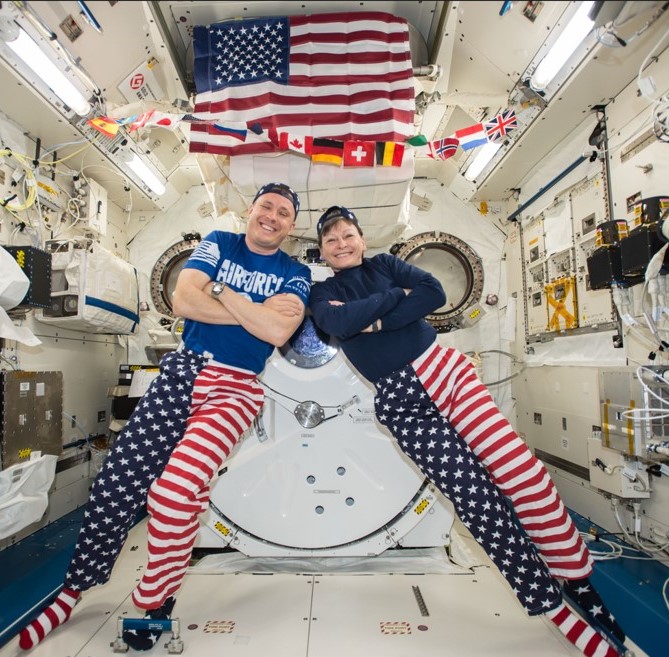
Left: July 4, 2015. NASA astronaut Scott J. Kelly records a Fourth of July message during Expedition 44. Right: July 4, 2017. During Expedition 52, NASA astronauts Jack D. Fischer and Peggy A. Whitson show off their patriotic outfits.
On July 4, 2015, NASA astronaut Scott J. Kelly, in the fourth month of his nearly one-year mission aboard the space station, recorded a Fourth of July message for Earthbound viewers. He wished everyone a Happy Independence Day and hoped that he would be able to see some of the fireworks around the country from his lofty perch, orbital mechanics permitting. As crew size aboard the space station increased and crew rotations changed, NASA astronaut Jeffrey N. Williams, celebrating his second Fourth of July in orbit during Expedition 48, holds the distinction as the last American to spend Independence Day alone in space on July 4, 2016. The following year, Expedition 52 astronauts Jack D. Fischer and Peggy A. Whitson recorded a whimsical video, posting it on social media, showing their patriotic attire in various poses.
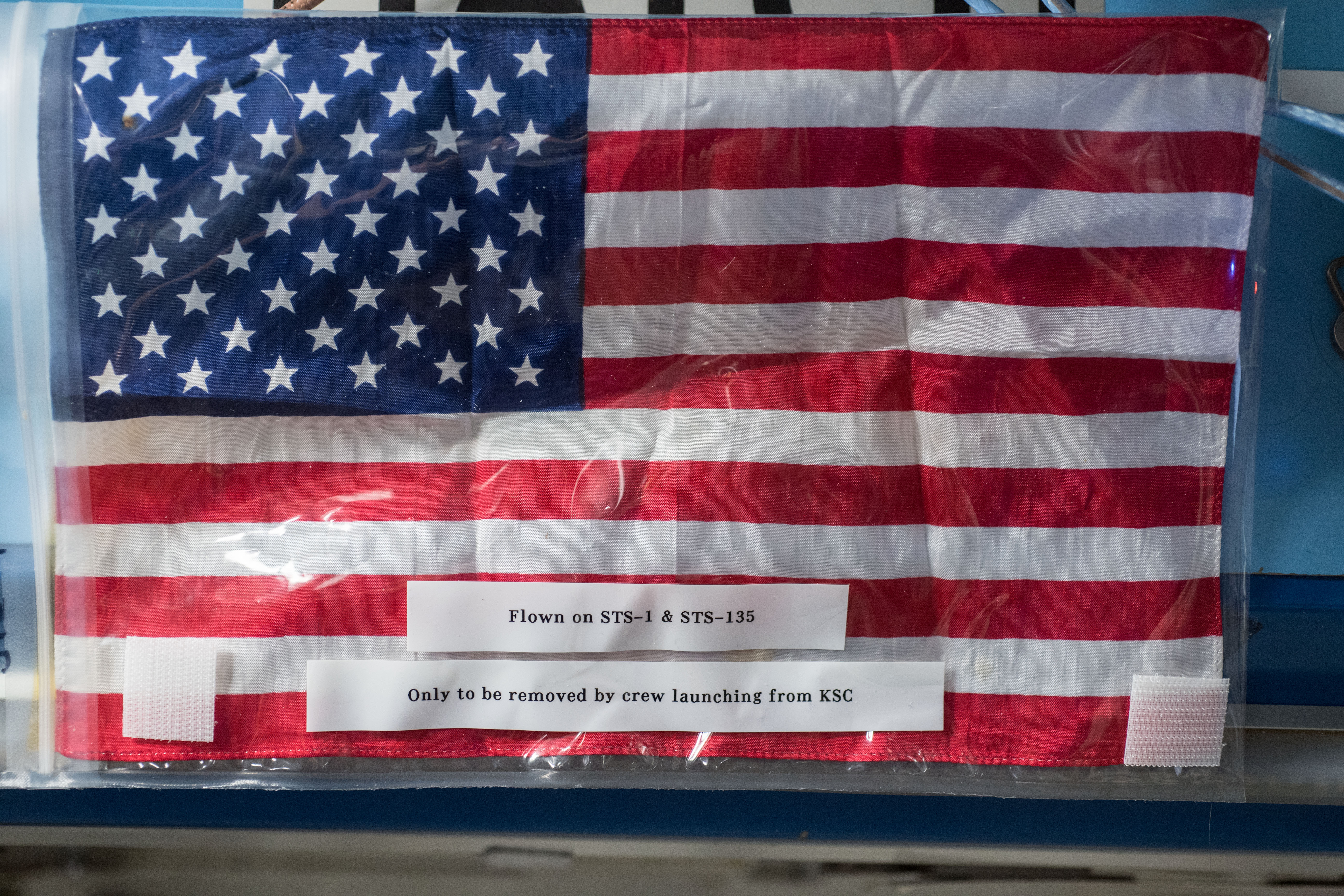
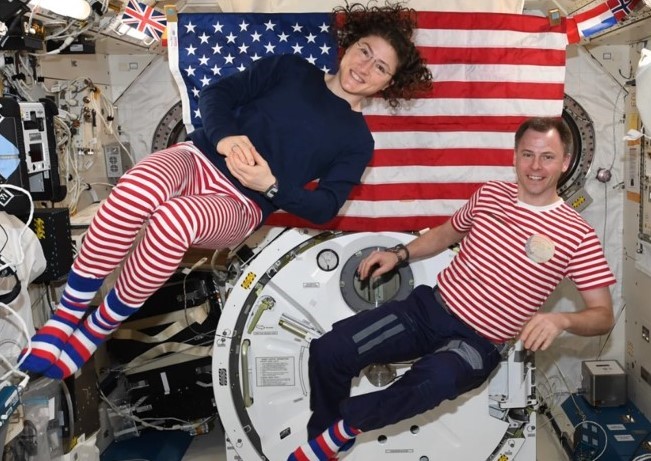
Left: July 4, 2018. The Expedition 56 crew found the American flag originally flown aboard STS-1 and brought to the space station by STS-135. Right: July 4, 2019. Expedition 60 astronauts Christina H. Koch and Tyler N. “Nick” Hague in their finest patriotic outfits.
For Independence Day 2018, Expedition 56 astronauts Andrew J. “Drew” Feustel, Richard R. “Ricky” Arnold, and Serena M. Auñón-Chancellor retrieved a very special flag from stowage. The 8-by-12-inch American flag first flew into space aboard STS-1, the space shuttle’s inaugural flight, in April 1981. One of a thousand flags flown, it ended up in storage for 20 years until retrieved and flown to the space station on the space shuttle’s final mission, STS-135, in July 2011. The label on the Legacy Flag, “Only to be removed by crew launching from KSC,” referred to the next launch of American astronauts from American soil aboard an American spacecraft, anticipated sometime after the shuttle’s retirement aboard a commercial provider. More on this flag’s incredible journey below. For Independence Day 2019, Expedition 60 astronauts Tyler N. “Nick” Hague and Christina H. Koch, in the fourth month of her record-breaking 11-month mission, to date the longest single flight by a woman, recorded a video message for Earthbound viewers. In particular, they thanked servicemen deployed around the world and reflected on the bright future for America’s human spaceflight program.
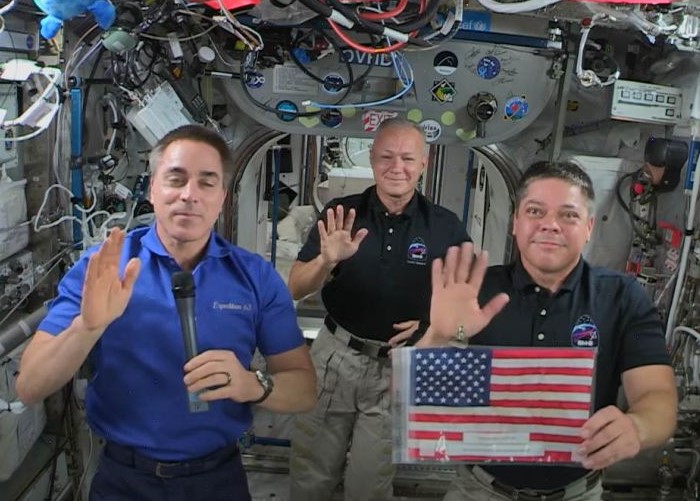

Left: July 4, 2020. Expedition 63 astronauts Christopher J. Cassidy, left, Douglas G. Hurley, and Robert L. Behnken, hold the Legacy Flag flown on STS-1 and STS-135. Right: July 4, 2021. The Expedition 65 crew, K. Megan McArthur, left, Mark T. Vande Hei, and R. Shane Kimbrough, tapes a Fourth of July message.
During their Independence Day video message on July 4, 2020, Expedition 63 astronauts Christopher J. Cassidy, Douglas G. Hurley, and Robert L. Behnken wished Americans a happy Fourth of July, and looked ahead to future missions to the Moon and beyond. Behnken, holding the Legacy Flag that had waited for them aboard the station for nine years, added that he and Hurley would return it to the ground since they had arrived aboard the first American crewed vehicle to launch from American soil following the retirement of the space shuttle. He indicated that the flag would later return to space aboard the first American crewed flight to the Moon as part of the Artemis program. In their video message on July 4, 2021, Expedition 65 astronauts K. Megan McArthur, R. Shane Kimbrough, and Mark T. Vande Hei wished everyone a Happy Fourth of July and looked forward to future exploration missions to the Moon.


July 4, 2022. Left: Expedition 67 NASA astronauts Robert T. Hines, left, and Kjell N. Lindgren during their recorded Fourth of July message. Right: The Expedition 67 crew photographed the American flag and its patches in the space station’s Cupola.
On July 4, 2022, Expedition 67 NASA astronauts Kjell N. Lindgren, Robert T. Hines, and Jessica A. Watkins spent the holiday aboard the space station. Lindgren and Hines recorded a video message wishing everyone a happy Fourth of July holiday. Hines posted on Twitter, now X, “Happy Birthday America! The crew of [Crew Dragon] Freedom and Expedition 67 wishes everyone back home a happy Independence Day!”
![On July 4, 2022, Expedition 67 NASA astronauts Kjell N. Lindgren, Robert T. Hines, and Jessica A. Watkins spent the holiday aboard the space station. Lindgren and Hines recorded a video message wishing everyone a happy Fourth of July holiday. Hines posted on Twitter, now X, “Happy Birthday America! The crew of [Crew Dragon] Freedom and Expedition 67 wishes everyone back home a happy Independence Day!”](https://www.nasa.gov/wp-content/uploads/2024/07/july-4-in-space-2024-23-exp-69-rubio-bowen-hoburg-2023.jpg)
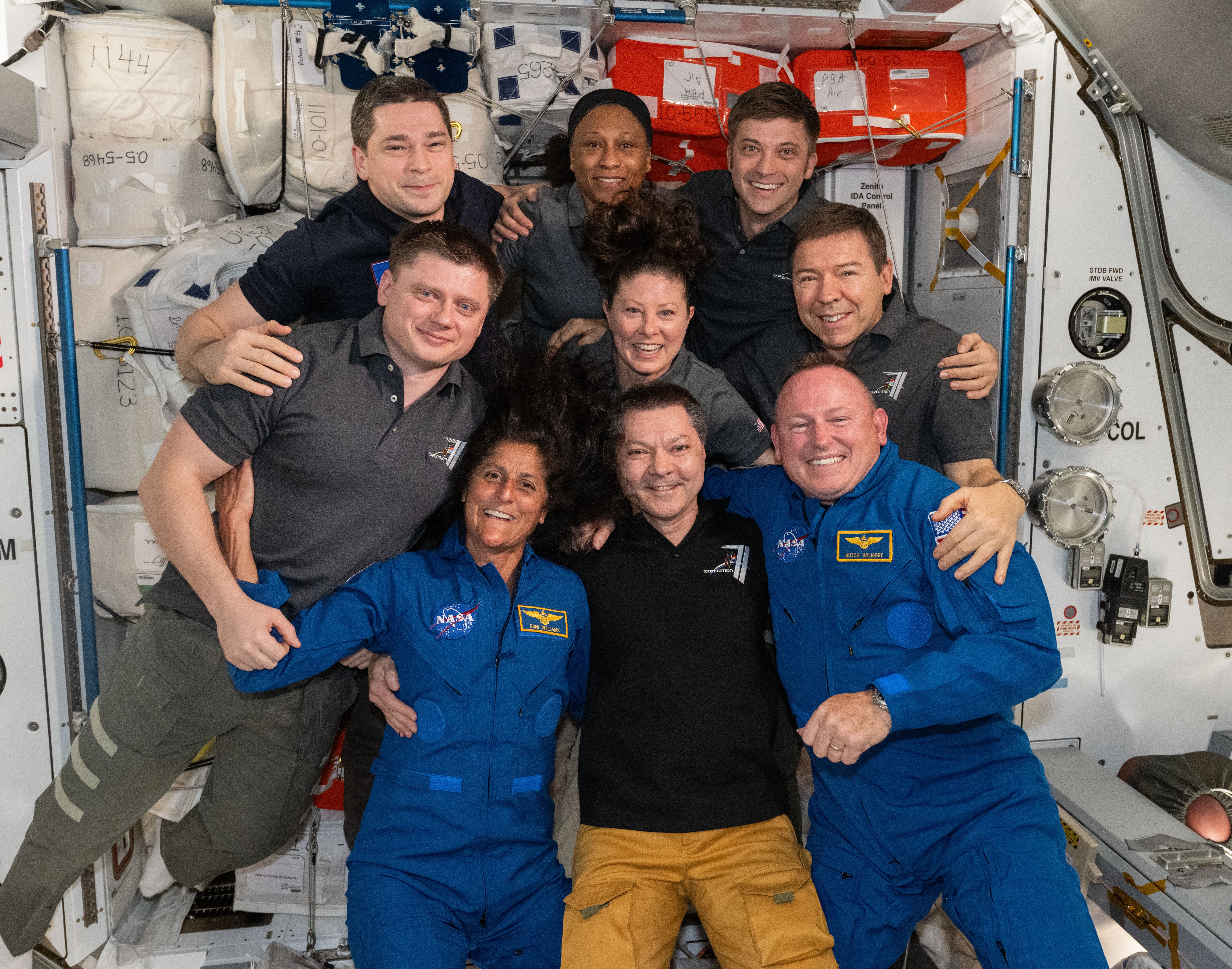
Left: July 4, 2023. Expedition 69 NASA astronauts Francisco “Frank” C. Rubio, left, Stephen G. Bowen, and Warren W. “Woody” Hoburg send an Independence Day greeting. Right: July 4, 2024. Six NASA astronauts onboard the space station for Independence Day.
In 2023, Expedition 69 NASA astronauts Francisco “Frank” C. Rubio, Stephen G. Bowen, and Warren W. “Woody” Hoburg recorded a Fourth of July greeting from the space station, played during “A Capitol Fourth” celebration in Washington, D.C., wishing everyone a Happy Independence Day. July 4, 2024, finds six NASA astronauts, the largest number of Americans in space on the Fourth of July since 2006, aboard the space station, having arrived by three different vehicles – Matthew S. Dominick, Michael R. Barratt, and Jeanette J. Epps by Crew Dragon, Tracy Caldwell Dyson by Soyuz, and Barry E. “Butch” Wilmore and Sunita L. Williams by Starliner. For Barratt and Dyson, this marked their second July 4 holiday in space. In the coming years, more American astronauts will celebrate Independence Day aboard the space station, and one day we can look forward to some of them celebrating the holiday on or near the Moon.
What's Your Reaction?



















.jpg?#)























